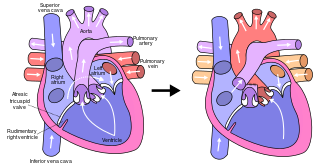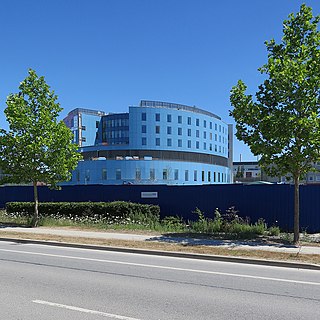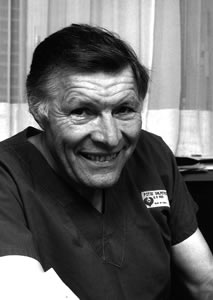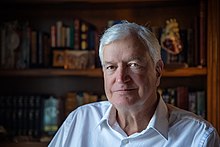
Pulmonary hypertension is a condition of increased blood pressure in the arteries of the lungs. Symptoms include shortness of breath, fainting, tiredness, chest pain, swelling of the legs, and a fast heartbeat. The condition may make it difficult to exercise. Onset is typically gradual.

The Fontan procedure or Fontan–Kreutzer procedure is a palliative surgical procedure used in children with univentricular hearts. It involves diverting the venous blood from the inferior vena cava (IVC) and superior vena cava (SVC) to the pulmonary arteries. The procedure varies for differing congenital heart pathologies. For example in tricuspid atresia, the procedure can be done where the blood does not pass through the morphologic right ventricle; i.e., the systemic and pulmonary circulations are placed in series with the functional single ventricle. Whereas in hypoplastic left heart syndrome, the heart is more reliant on the more functional right ventricle to provide blood flow to the systemic circulation. The procedure was initially performed in 1968 by Francis Fontan and Eugene Baudet from Bordeaux, France, published in 1971, simultaneously described in 1971 by Guillermo Kreutzer from Buenos Aires, Argentina, and finally published in 1973.

Endarterectomy is a surgical procedure to remove the atheromatous plaque material, or blockage, in the lining of an artery constricted by the buildup of deposits. It is carried out by separating the plaque from the arterial wall.

In thoracic surgery, a pulmonary thromboendarterectomy (PTE), also referred to as pulmonary endarterectomy (PEA), is an operation that removes organized clotted blood (thrombus) from the pulmonary arteries, which supply blood to the lungs.
Bruce A. Reitz is an American cardiothoracic surgeon, best known for leading the first combined heart-lung transplantation in 1981 with pioneer heart transplant surgeon Norman Shumway. He obtained an undergraduate degree at Stanford University a medical degree at Yale Medical School and completed an internship at Johns Hopkins Hospital (1971) and residencies and fellowships at Stanford University Hospital the National Institutes of Health (1974). He joined the surgical faculty at Stanford University (1978) then became chief of cardiac surgery at Johns Hopkins University (1982–92) and Chairman of the Department of Cardiothoracic Surgery at Stanford (1992–2005). In 1995 he conducted another pioneering operation: the first Heartport procedure, using a device that allows minimally invasive coronary bypass and valve operations. Reitz also played a major role in the resident education program at Stanford, which he reorganized and maintained.

Royal Papworth Hospital is a specialist heart and lung hospital, located on the Cambridge Biomedical Campus in Cambridgeshire, England. The Hospital is run by Royal Papworth Hospital NHS Foundation Trust.

Atrial septostomy is a surgical procedure in which a small hole is created between the upper two chambers of the heart, the atria. This procedure is primarily used to palliate dextro-Transposition of the great arteries or d-TGA, a life-threatening cyanotic congenital heart defect seen in infants. It is performed prior to an arterial switch operation. Atrial septostomy has also seen limited use as a surgical treatment for pulmonary hypertension. The first atrial septostomy was developed by Vivien Thomas in a canine model and performed in humans by Alfred Blalock. The Rashkind balloon procedure, a common atrial septostomy technique, was developed in 1966 by American cardiologist William Rashkind at the Children's Hospital of Philadelphia.
Norman Edward Shumway was a pioneer of heart surgery at Stanford University. He was the 67th president of the American Association for Thoracic Surgery and the first to perform an adult human to human heart transplantation in the United States.

A heart transplant, or a cardiac transplant, is a surgical transplant procedure performed on patients with end-stage heart failure or severe coronary artery disease when other medical or surgical treatments have failed. As of 2018, the most common procedure is to take a functioning heart, with or without both lungs, from a recently deceased organ donor and implant it into the patient. The patient's own heart is either removed and replaced with the donor heart or, much less commonly, the recipient's diseased heart is left in place to support the donor heart.
Sharon Ann Hunt is a cardiology professor and Director of the Post Heart Transplant Programme in Palo Alto, California and is affiliated with Stanford University Medical Center, professionally known for her work in the care of patients after heart transplantation.

Hans-Joachim Schäfers is a German surgeon, as well as cardiac, thoracic, and vascular surgeon and university professor. He is director of the department of Thoracic and Cardiovascular Surgery at the Saarland University Medical Center in Homburg/Saar, Germany. He is known for his activities in aortic valve repair, aortic surgery, and pulmonary endarterectomy.

Christian Emile Cabrol was a French cardiac surgeon best known for performing Europe's first heart transplant at Pitié-Salpêtrière Hospital in 1968.
Chronic thromboembolic pulmonary hypertension (CTEPH) is a long-term disease caused by a blockage in the blood vessels that deliver blood from the heart to the lungs. These blockages cause increased resistance to flow in the pulmonary arterial tree which in turn leads to rise in pressure in these arteries. The blockages either result from organised blood clots that usually originate from the deep veins of the lower limbs of the body (thromboembolism) and lodge in the pulmonary arterial tree after passing through the right side of the heart. The blockages may also result from scar tissue that forms at the site where the clot has damaged the endothelial lining of the pulmonary arteries, causing permanent fibrous obstruction. Most patients have a combination of microvascular and macrovascular obstruction. Some patients may present with normal or near-normal pulmonary pressures at rest despite symptomatic disease. These patients are labelled as having chronic thromboembolic disease (CTED).
Philip Caves (1940–1978) was an Irish cardiothoracic surgeon. In 1972, while at Stanford University, he pioneered the use of the bioptome and transvenous endomyocardial biopsy in the early diagnosis of heart transplant rejection. It was considered the most significant advance in antirejection therapy of the time. Awarded the British American Research Fellowship in 1971, Caves worked with pioneering cardiothoracic surgeon Norman Shumway at Stanford and became staff surgeon leading the transplant programme by 1973. A year later he went to Edinburgh as a senior lecturer in cardiac surgery, where he became particularly interested in pediatric cardiac surgery.

The International Society for Heart and Lung Transplantation (ISHLT), established in 1981, is a professional organization committed to research and education in heart and lung disease and transplantation. It holds annual scientific meetings and publishes The Journal of Heart and Lung Transplantation. It also holds the worlds largest registry of heart and lung transplant data.
Jack Greene Copeland is an American cardiothoracic surgeon, who has established procedures in heart transplantation including repeat heart transplantation, the implantation of total artificial hearts (TAH) to bridge the time to heart transplant, innovations in left ventricular assist devices (LVAD) and the technique of "piggybacking" a second heart in a person, while leaving them the original.

Michael Peter Kaye was an American surgeon and researcher who co-founded the International Society for Heart and Lung Transplantation (ISHLT) in 1981. He developed the society's registry and edited the Journal of Heart and Lung Transplantation.
Edward B. Stinson is an American retired cardiothoracic surgeon living in Los Altos, United States, who assisted Norman Shumway in America's first adult human-to-human heart transplantation on 6 January 1968 at Stanford University.

Michael L. Hess was an American professor of cardiology and physiology at the Medical College of Virginia (MCV) who was instrumental in founding the International Society for Heart and Lung Transplantation (ISHLT), of which he served as its first president.

Balloon pulmonary angioplasty (BPA) is an emerging minimally invasive procedure to treat chronic thromboembolic pulmonary hypertension (CTEPH) in people who are not suitable for pulmonary thromboendarterectomy (PTE) or still have residual pulmonary hypertension and areas of narrowing in the pulmonary arterial tree following previous PTE.


















